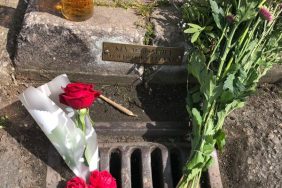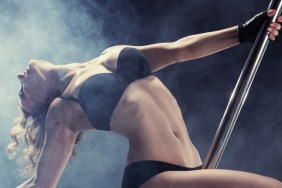Time travel button by whatleydude via Flickr.
There are events and world happenings that we all wish we’d been alive to witness. My dad fondly recalls his tripped-out visit to Woodstock, and though he has no photographs from the event, when he talks about it I feel like I was there. Rather than wander down a nostalgic history of days past with dad, I decided to hop in the time-traveling Delorean and go visit the events that I most wish I’d attended. For this trip down the wormhole, I resurrected six art, literary and theater events that we can all go to together. It’s not a trip down memory lane. This is back to the future!
1. The Premiere of Federico Garcia Lorca’s Play Blood Wedding (1932)

Sculpture of Playwright Federico Garcia Lorca via Flickr
Playwright Federico Garcia Lorca’s Blood Wedding, a play about love, honor and the attempts to preserve appearances that ultimately results in death, is often times referred to as one play in his three-part trilogy which also includes Yerma and The House of Bernarda Alba. Fate plays a heavy role in all of Lorca’s plays, and as a playwright he also uses environment to create a strong sense of time and place. I would time travel back to 1933 in Madrid to witness the original premiere of this masterpiece.
2. American premiere of Jean-Paul Sartre’s play No Exit (1946)

Painted portrait of Jean-Paul Sartre by thierry ehrmann via Flickr
Written in 1944, this French Existentialist play basically governed my ideas about life as a teenager, and I read it numerous times at some café while attempting to look cool by smoking cigarettes and drinking weak, bad coffee. A play about three dead people who are trapped in a room together as punishment for eternity, this is where the saying “Hell is other people” was originally coined. I would love to travel back in time to the American post-World War 2 premiere that rocked theater history and liberal arts colleges forever.
3. Faith Wilding at Womanhouse in Los Angeles (1974)

Still from Faith Wilding’s “Waiting” performance as seen in the 1974 film “Womanhouse” by Johanna Demetrakas, (1974, USA, 47 min.) (courtesy of Johanna Demetrakas and Three Walls Gallery). Image via Hyperallergic.
In 1974, Faith Wilding read her epic poem “Waiting,” speaking of (white) second wave feminism and sexual exploration without attachment to labels. Her performance of “Waiting” outlines all the things a girl/lady/woman would be expected to “wait” for in her lifetime. I would love to travel back in time to see the original performance. (In my contemporary life, I experienced Faith on the Internet, especially through re-readings of her original works.)
4. Public Opening of Judy Chicago’s The Dinner Party at SF MoMA

Judy Chicago (American, b. 1939). The Dinner Party, 1974–79. Mixed media: ceramic, porcelain, and textile. Brooklyn Museum, Gift of the Elizabeth A. Sackler Foundation, 2002.10. © Judy Chicago. (Photo: © Donald Woodman). Image via Brooklyn Museum.
Traveling back in feminist histories just wouldn’t be complete without a visit to the first public opening of Judy Chicago’s iconic The Dinner Party on March 14, 1979 in San Francisco. Popularly knowin as “the first feminist artwork,” this piece sets a triangle-shaped table for 39 famous women throughout world history, including Sappho, Judith, Artemisia Gentileschi, Sojourner Truth, and Sacajawea. What would it have been like to see this original rendering of imagining amazing women gathered together? In my dreams, I’d like to know.
5. First Film Screening of Marlon Riggs’ Tongues Untied (late 1980s)

Installation view of Tongues Untied, June 6 – September 13, 2015 at MOCA Pacific Design Center, courtesy of The Museum of Contemporary Art, Los Angeles, photo by Brian Forrest. Image via moca.org.
I have always been in awe of the honesty and brute emotional strength that it took for filmmaker and gay rights activist Marlon Riggs to make his experimental film Tongues Untied (1989), about the gay black experience. Riggs, whose work tackled homophobia and racism, must have had a first original screening of this film somewhere in the SF Bay Area, where he lived. If I were somehow invited to that private screening even though I am a white cis queer woman, I would definitely travel back in time to attend.
6. Sensation at the Brooklyn Museum (1999-2000)

Sensation: Young British Artists from the Saatchi Collection, October 2, 1999 through January 9, 2000 (Image: PSC_E1999i107_SL3.jpg. Brooklyn Museum photograph, 1999). Image via BrooklynMuseum.org
In the 1990s, Charles Saatchi was known to both support and collect the works of the Young British Artists (YBAs), including Tracey Emin, Jake and Dinos Chapman, Gary Hume, Marc Quinn, Sam Taylor-Wood, Marcus Harvey, and Damien Hirst. Their technique tended to be one of both high shock value and lushly visual in nature, and always engaged with consumer culture. In 1999, the Brooklyn Museum organized the show Sensation: Young British Artists from the Saatchi Collection, which brought the YBAs to the States.








